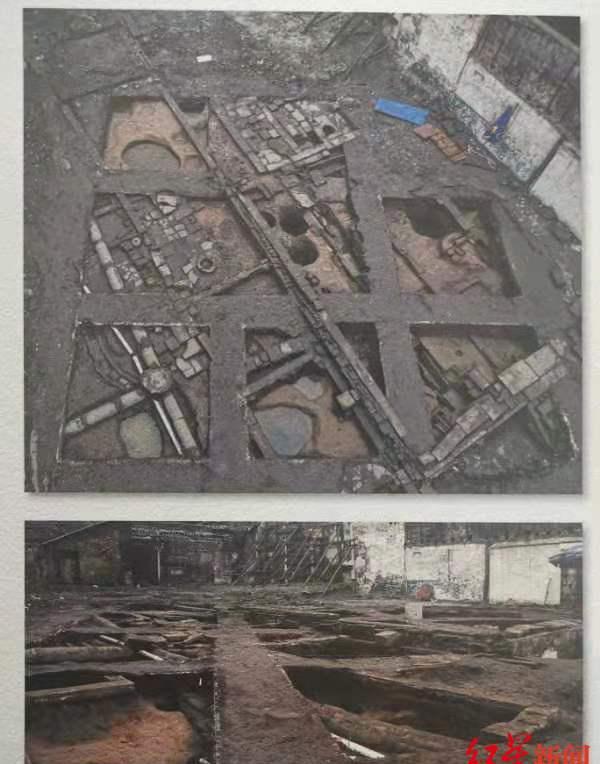On December 17, at the opening ceremony of the 2021 China International Famous Wine Expo, Tang Fei, president of the Sichuan Institute of Cultural Relics and Archaeology, released the results of the "Archaeological Wuliangye" project, which lasted 18 months of archaeological excavation and research, providing empirical evidence for the Yibin Duoliang Daqu winemaking technology and the Wuliangye ancient cellar pond group with the "crypt-style qujiu fermentation cellar pond" as the main feature to advance to the Yuan Dynasty, providing clues for tracing the history of liquor brewing in Yibin and even southern China.

Yibin Zouma Street Ruins
The upper limit found in the "Fire House Brewing Workshop Site" is the Yuan Dynasty, the main body is the Ming and Qing Dynasty winemaking workshops, and its cellar pond is a common crypt-type cellar pond in the production of multi-grain Daqu wine, which is the same as the cellar pond that continues to be used in wuliangye ancient winery. The stoves found in Wuliangye Zhongsan and the workshop from the early Ming Dynasty are also the same as the basic shape of the stoves at the site, which shows that the winemaking facilities of the two have overlapping ages. Considering the distribution of the ancient commercial pattern and the characteristics of the urban pattern, the Wuliangye Ancient Cellar Pond Group and the site should appear and form in the same period, which is a typical homology of the same root. Basically clarified the development history of Yibin distilled liquor represented by Wuliangye from the Yuan to the Qing Dynasty.
Tang Fei said that this discovery not only traces the birth date of wuliangye ancient cellar pond group back to the Yuan Dynasty, but also shows that Yibin is the earliest region in China to produce large-scale liquor, providing scientific archaeological evidence for the study of the origin and development of distilled liquor in China.
It is understood that the "Archaeological Wuliangye" is currently the archaeological work with the largest number of participants, the most complete use of disciplines, the longest continuous working hours, the strongest lineup of experts, the best preservation of the pattern of the front shop and the back of the shop, and the most complete elements of the excavation of winemaking sites in the archaeological history of China's wine industry. More than 100 archaeologists participated, bringing together more than 30 domestic archaeology and industry top experts, using multidisciplinary collaboration, scientific and technological archaeology and traditional archaeology to carry out archaeological research, the total excavation area of the project exceeded 2,000 square meters, 95 relics were found, and more than 600 restorable cultural relics were unearthed.
Unearthed porcelain pieces
On the basis of the archaeological survey of the whole territory of Yibin, Sichuan, archaeologists have focused on the archaeological excavation work of the "Ruins of the Fire House Brewing Workshop", the "Zouma Street Ruins" of the ancient official road in history, the "Yejia Courtyard Ruins" adjacent to liu Dingxing Ancient WineRy, and the "501 Workshop" of Wuliangye, all of which have achieved important archaeological results.
As the general leader of the "Archaeology Wuliangye" project, Tang Fei said that the excavation used comprehensive archaeological means to extend from wine industry archaeology to urban archaeology, and traced the human settlement, production and living years in Yibin City to the early and middle Shang Dynasty. Through investigation and exploration and soil sample analysis of cultural layers, cultural accumulation layers dating back to about 3500 years were found in the area of Zhangwan and Gujiufang of Wuliangye. At the same time, according to the historical records of the bronze ware "僰卣" in the Shang and Zhou Dynasties, the history of human activities in the main urban area of Yibin is traced back to the early and middle Shang Dynasties from the perspective of combining archaeological evidence and documentary data.
"Archaeology Wuliangye" enriches the physical data of the history of Yibin's urban development since the Han Dynasty. In the "Ruins of the Fire House Brewing Workshop", rich relics from the Han, Wei and Jin Dynasties, Sui and Tang Dynasties, Song and Yuan Dynasties, Ming and Qing Dynasties have been unearthed. The remains of the Ming Dynasty city wall, the Qing Dynasty street shop buildings, and the large municipal drainage facilities of the Ming and Qing Dynasties were also found, indicating that the site and its neighboring Wuliangye Changfa Sheng Ancient WineRy are the earliest developed areas in Yibin area, and the historical and cultural heritage is rich.
Tang Fei said that the "Archaeological Wuliangye" project proved through physical evidence that Yibin Ming Dynasty was already a very prosperous city in the winemaking industry, with many workshops, drinking consumption, storage, wharves, water transportation, and urban patterns, all around the rise of the winemaking industry. In terms of urban development, it is very similar to Jingdezhen, which has arisen with the ceramic industry. "Baijiu is a representative of urban industrial civilization." "The ceramics excavated by 'Wuliangye Archaeology' are very rich, which can be called a microcosm of the Ming and Qing ceramics industry in Yibin." Tang Fei suggested that Yibin should protect the site and prepare for the declaration of Chinese liquor as a world cultural heritage and the future display and utilization.
Red Star News reporter Luo Min
Edited by Wang He
(Download Red Star News, there are prizes for the newspaper!) )